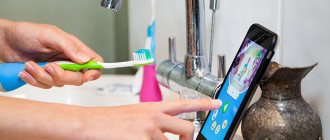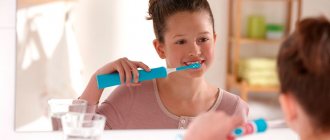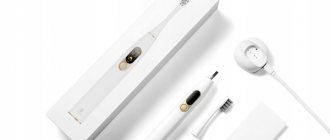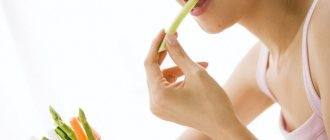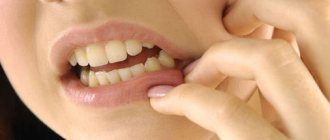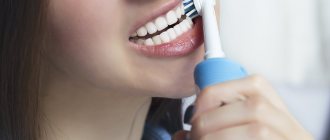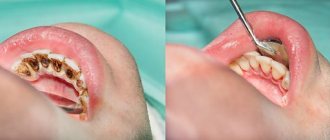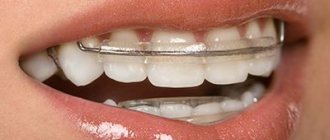Since dentistry began to develop, the way we brush our teeth has undergone many changes. This process especially affected the toothbrush. In the 20th century, no one attached importance to the softness of the bristles or their number, much less their direction.
Today there are a number of differences between a brush and a pen. Experts say that everyone who cares about oral health and the beauty of their smile should choose a toothbrush taking into account their natural characteristics. So, how to choose this simple item for the main morning and evening ritual.
How to find out the degree of hardness: decoding the markings
You should choose a toothbrush from a trusted manufacturer.
It is better if it is a company with global experience.
Check that the packaging is intact and there is no damage or dents on the fibers.
Next, you need to look for a designation of the degree of hardness or softness. They are: sensitive, soft, medium, hard, extra-hard.
Read more.
- Sensitive translated from English means sensitive. Suitable for people with various gum diseases (gingivitis, stomatitis, periodontal disease, hyperesthesia, etc.).
- Soft translated from English is soft. Ideal for people whose gums are prone to inflammation and swelling. Typically, owners of this quality are distinguished by thin skin, a tendency to irritate the mucous membranes and the close location of blood vessels on the face.
- Medium translated from English is average. If a person has good health, can handle hot and cold well, and doesn’t even know what blood is when brushing his teeth, this brush will be ideal for him.
- Hard translated from English means tough, hard. If the condition of your oral cavity is normal, a toothbrush with medium-hard bristles will be optimal for you, but this toothbrush will not cause injury.
- Extra-hard translated from English - extra-hard. In many countries, toothbrushes with this hardness have been discontinued. They are suitable for those whose health can be defined as impeccable. Buyers often mistakenly prefer such bristles, believing that they clean their teeth better. Unfortunately, it is not. Auxiliary products will help improve the quality of teeth cleaning: rinsing solutions, dental floss, ultrasonic brushes. And hard bristles will only disturb the gums, which will definitely not improve the health of the oral cavity.
In fact, toothbrushes labeled extra-hard are the cheapest and use the least amount of manufacturing resources. If you add a couple more plastic decoy blocks, the cost is greatly underestimated, and the buyer mistakes the “sophisticated” model for a high-tech one.
Soft and not very...
Read more…
As for bristles, today, in addition to nylon, other synthetic materials are used, which allows you to select a brush individually - taking into account the shape of the handle and head and the frequency and stiffness of the fibers, which dentists divide into five degrees. By the way, the degree of hardness is indicated on the packaging, and you need to pay attention to it, especially if you have problems with gums, bleeding and some chronic diseases. So, what types of brushes are there?
✅ Very soft (sensitive) . Recommended for children and people with gum problems.
✅ Soft . Recommended for bleeding gums, as well as for diabetics, pregnant and lactating women.
✅ Medium hardness . Designed for adults with a healthy oral cavity.
Read more…
✅ Hard . Recommended for smokers, coffee lovers and people with increased plaque formation with a healthy oral cavity and strong enamel.
✅ Extra hard brushes (extrahard) . Suitable for people with increased plaque formation and in the presence of orthopedic or orthodontic structures: complete removable dentures, fixed bridges and braces.
In any embodiment, the bristles are collected in tufts, which are located at one, two or three levels parallel or at an angle to each other. Some brushes have bristles of different heights. In this case, each group performs its own functions.
Some people prefer electric toothbrushes. It was first patented in Switzerland in the first half of the fifties. And in 1992, Dr. Robert Bock patented an ultrasonic brush.
Types of stubble
Natural bristles
Toothbrushes with such a brush are practically not produced today, as they are distinguished by two impressive disadvantages. The first is high wear resistance. The second is increased bacteriality, associated with a strong tendency to absorb moisture, which, in turn, creates an excellent environment for the reproduction and life of dangerous bacteria.
Natural bristles
Among the advantages, it is worth noting the most gentle action. Such brushes simply cannot be hard or extra-hard. So trauma is completely eliminated. Although it is worth admitting that experts are still arguing whether such brushes cope with cleaning teeth at the required level in principle.
Pay attention to the President line of toothbrushes - they are as natural as possible and, unlike analogues, undergo an additional stage of quality control.
Artificial bristles
Modern brushes are almost all made of nylon, a highly durable material that can be molded into any shape. It is colored, hardened, and even charcoal is added, which, as manufacturers claim, gives the brush bacterial properties.
How to choose the right brush for cleaning your teeth?
For an adult
- Assess the condition of your oral cavity. Pay attention to soft brushes. The fewer injuries on the gums and micro-scratches on the enamel, the longer your teeth will maintain their health.
- If a person is allergic to nylon (which is, of course, extremely rare), look for toothbrushes made from natural materials. In this case, do not forget to change this hygiene item at least once a month. Or, as a last resort, subject it to boiling or another method of disinfection at least once a week.
- Choose a handle that is comfortable for you - so that it fits comfortably in your hand and contains as little plastic as possible (a brush that is too bulky can again injure your gums and cheeks). Remember that the soft parts on it are also excellent breeding grounds for bacteria that can penetrate into pores and cracks that are invisible to the eye.
Variety of brushes
For a child
So, what should you pay attention to when buying a toothbrush for your child? The bristles should be soft or very soft so as not to damage the mucous membrane of the gums when cleaning and not to abrade the hard tissues of the teeth. The bristles should also be artificial. Natural brushes provide the most favorable conditions for the accumulation and proliferation of bacteria. When using this, the risk of infection of the oral cavity is extremely high, manifested in frequent stomatitis and gingivitis.
The size of the working part of the brush (head) should be small. Its size should not exceed the width of two adjacent baby teeth (approximately 2 cm).
Types of brushes
Pen. For the first teeth (up to a year) it does not matter, since for now ONLY an adult brushes their teeth. In the future (from one year onwards), the handle of the toothbrush is of great importance. For convenience, it is better to choose rubberized toothbrushes, of which manufacturers have a huge variety in their children's line.
For a pregnant woman
During pregnancy, women are prone to swelling and increased sensitivity. It is better if the toothbrush during this period is also selected accordingly. Choose copies from global manufacturers (to avoid low-quality counterfeits and unsanitary production conditions).
The second problem that pregnant women very often face is an increased gag reflex. Sometimes brushing your teeth is almost impossible. In this case, you should purchase a mono-tuft toothbrush (more about it below).
Fashionable ultrasonic brushes are not suitable for women during this special period of life . Their effectiveness has indeed been proven, they perfectly cleanse the oral cavity of germs and bacteria, but, unfortunately, whether there is any effect on the child is unknown. A full-fledged study requires decades and significant investments, so it is unlikely that positive news can be expected in the near future.
Classification
At the moment, toothbrushes are classified into 3 degrees of hardness:
- Soft.
- Average.
- Tough.
It is necessary to understand that properly selected oral care will provide anyone with a beautiful and healthy smile . But choosing the wrong toothbrush can ruin the condition of your teeth and damage your gums, which can lead to various oral diseases in the future.
The most popular toothbrush to use is a toothbrush with stiff bristles . However, to use this tool safely, you should understand the essence of its purpose and know about all its pros and cons. Using a hard toothbrush has a number of advantages.
Toothbrush head
Many people are attracted to toothbrushes lying on the counter with a thick rubber handle and a bunch of additional bulges and roundness.
In fact, the most expensive and high-quality toothbrush is a mono-tuft toothbrush.
The diameter of the head of such a device is only a few millimeters, and brushing your teeth with it will take twice as long, but the efficiency is several times greater than that of a standard toothbrush.
The fact is that many people are not able to thoroughly clean all their teeth due to the gag reflex.
Dentists are constantly faced with the fact that distant teeth, wisdom teeth, which, as a rule, simply cannot be reached with a regular brush, are susceptible to caries and various damages. So, a mono-beam brush was literally created to solve this problem.
They also come in several types of hardness.
Selecting a brush based on the location of the tufts:
- Hygienic : the bundles are even and straight, of the same length. Most often, this option is found among children's brushes.
- Preventive . On these brushes, the tufts can be located in completely different directions and can have different lengths and hardness. There may also be rubber bristles on the sides to massage the gums.
- Special . Option for cleaning plaque from implants, etc. Buy in pharmacies or to order.
How often should it be changed?
On average, you change your toothbrush every three months. But, if a person prefers to brush his teeth three times a day, does it actively and vigorously, his toothbrush will wear out noticeably faster. Thus, it is necessary to change this hygiene item as it wears out. For natural brushes, the service life is also noticeably reduced. Dentists agree - the more often the replacement occurs, the better.
The quality of teeth cleaning depends on the brush
A toothbrush is one of the most important hygiene items. How uncomfortable we feel if it is not at hand in the morning! It should not be treated with negligence. Do not neglect hygiene, wash it with bacterial soap, dry it, do not throw it on the sink in a hurry, and do not transport it without a cover. And most importantly - change it more often!
If you have encountered at least one dental problem in the oral cavity, do not skimp on your toothbrush. It must be remembered that both emotional and psychological health depend on dental health. Everything in the body is interconnected. And teeth are an important part of it, providing us with high comfort and standard of living.
Product care
The basics for proper use are the following:
- You should consider a toothbrush as an individual hygiene product. This means that only one person can use the product, otherwise it will simply turn into a source of infection.
- Storage rules must be followed. As soon as the product is used, you need to wash it thoroughly and place it vertically in a container with the top up. The microflora of family members should not overlap, and therefore each member should have their own products.
- The brush cannot be stored in a closed case, as it must be dry. A humid environment promotes the rapid spread of bacteria. The cover does not allow the brush to dry thoroughly.
- It needs to be changed every three months, or even more often. The hygiene product should not be worn out. This rule also applies to removable attachments for electric brushes. If the villi are deformed, you cannot continue to use the product. For this reason, mucous membranes and enamel may be damaged.
- The brush should always be washed with soap to remove any remaining plaque and toothpaste.
When choosing individual care products, it is better to seek advice from a specialist. Based on the individual characteristics of the body, the dentist will recommend certain models.
